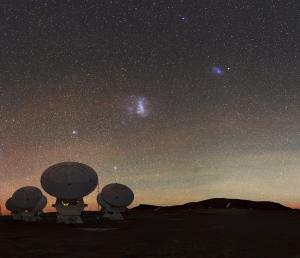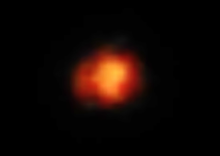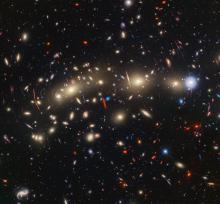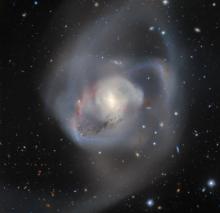The Magellanic Clouds -- two companion galaxies of the Milky Way -- shine through the dark skies above ALMA, a large radio telescope array in Chile. Recent research says that the two clouds collided about 150 million years ago, stripping most of the star-making gas from the smaller of the two galaxies. [ESO/S. Guisard]
You are here
Galactic Smash-Up
Dozens of galaxies orbit our own, but none compares to the Magellanic Clouds. These two galaxies are so bright and vibrant that they’re visible to the eye alone — but only from the southern hemisphere.
Hubble Space Telescope has tracked the motions of stars inside the smaller of the two galaxies. The observations suggest that it’s in serious trouble — the result of a recent collision with its brighter neighbor, the Large Magellanic Cloud.
The Small Magellanic Cloud is 200,000 light-years from Earth. The recent observations indicate that, unlike both the Milky Way and the Large Magellanic Cloud, the Small Cloud isn’t rotating. And stars on its outskirts are streaming away from its center, indicating that the outer regions of the galaxy are disintegrating.
The Hubble work also tracked the cloud’s path, and found the cause of its distress: it smashed right through the large cloud, which is about 10 times more massive. The collision occurred just 150 million years ago. The collision probably scrambled the stars so that they no longer orbit a common center. And it caused the galaxy to lose lots of gas.
As a result, its fate looks bleak. It probably will lose all of its gas, so it won’t be able to make more stars. This process will take a long time, though. So both of the Magellanic Clouds will shine brightly for a long time to come.
Script by Ken Croswell
Our thanks to Edward Pfiester, the sponsor of today's program!
Get Premium Audio
Listen to today's episode of StarDate on the web the same day it airs in high-quality streaming audio without any extra ads or announcements. Choose a $8 one-month pass, or listen every day for a year for just $30.






